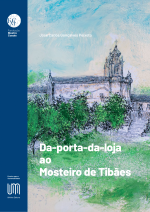Da-porta-da-loja ao Mosteiro de Tibães
Palavras-chave:
Maçã da Porta da Loja, Mosteiro de TibãesSinopse
Esta obra convoca a atenção para a simbiose entre a maçã-da-porta-da-loja e a sua origem atribuída ao mosteiro de Tibães. Tendo em conta as circunstâncias e o poder senhorial, procuramos, no âmbito da historiografia portuguesa, conectar o berço deste fruto com a freguesia de Mire de Tibães e com o núcleo alargado da família Casais, fiel depositária deste património lendário. Entendemos que os argumentos apresentados, apoiados em boas fontes e nos dados recolhidos, sustentam a hipótese formulada, reconstituindo cientificamente o pretérito, à luz das metodologias que a evolução imprimiu à história local.
Ficamos atónitos quando encontramos documentos que focavam a descoberta de velhas e maduras macieiras na cerca conventual. Tudo se deveu à audácia dos antigos caseiros do mosteiro de Tibães, os «Casales – Casais» que, ao disseminarem pelas quintas circundantes, não deixaram que esta variedade caísse em vias de extinção, num contexto de economia verde e da temática da sustentabilidade.
Desvendamos que a variedade da «maçã-da-porta-da-loja» é uma herança beneditina, produzida num dos poios, ou socalcos da cerca conventual e, posteriormente, difundida pelas quintas da região. Esta dádiva é mais que uma memória histórica e cronológica, é uma tomada de consciência qualitativa na busca de uma identidade, de legados sociais, morais e económicos, pois sempre respeitamos a transmissão de testemunhos, a tradição e o legado dos antepassados como símbolo identitário da aldeia.
Procuramos distribuir o nosso contributo por três partes. No primeiro capítulo, procuramos desvendar o mistério que envolve a maçã-da-porta-da-loja, especificamente, a conexão com a herança monástica de Tibães, bem como uma abordagem histórica da agricultura no seio beneditino em geral e, em particular, da fruticultura nas propriedades do mosteiro de Tibães, patrimónios que sustentavam a vida religiosa do instituto monástico. No segundo capítulo elaboramos uma abordagem sobre o domínio fundiário do senhorio do mosteiro de Tibães, que conheceu muitas vidas. Viu nascer algumas e perdeu outras tantas. No terceiro capítulo, procedemos a uma breve referência e mais contemporânea sobre a caracterização, origens e tradições da maçã-da-porta-da-loja, de que tanto nos orgulhamos, do que temos e do que vamos fazer para a defender enquanto fruto de eleição.
Downloads

Downloads
Publicado
Séries
Categorias
Licença

Este trabalho encontra-se publicado com a Licença Internacional Creative Commons Atribuição 4.0.






